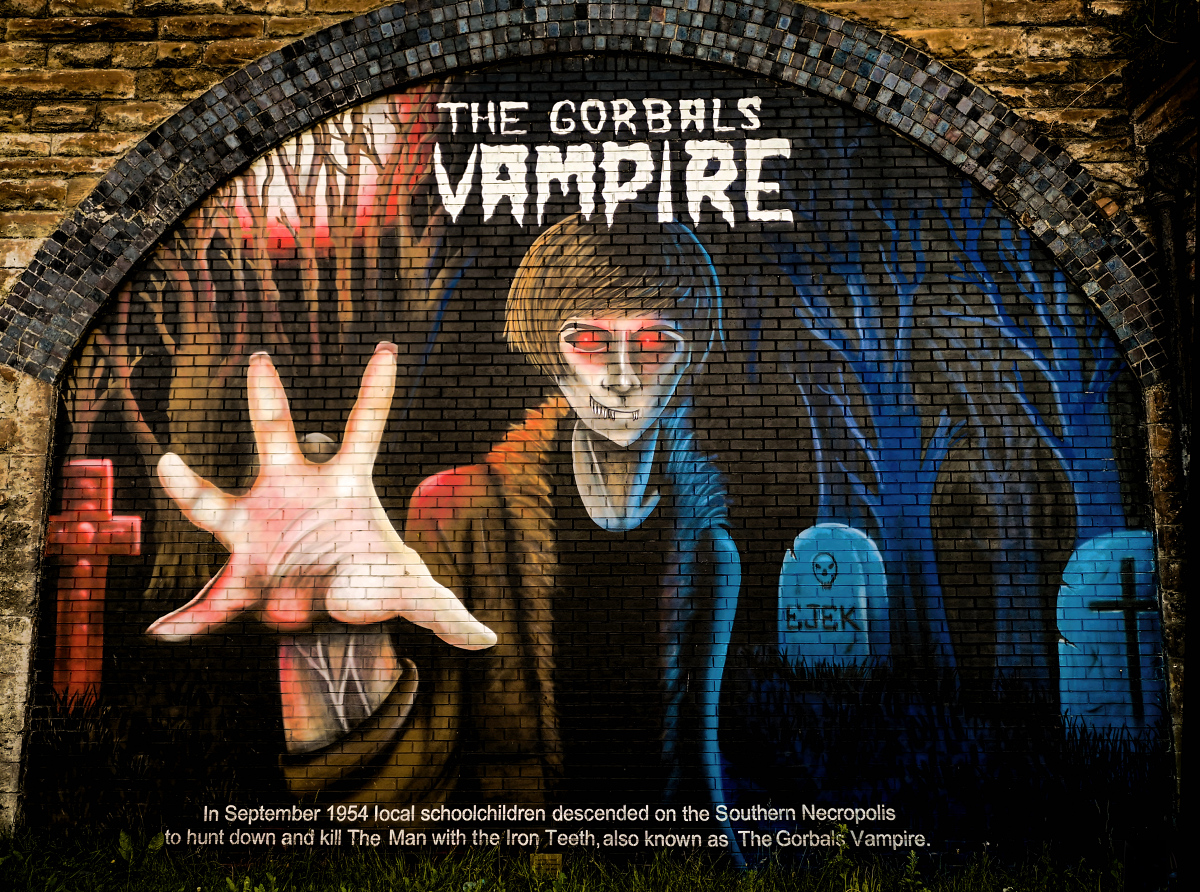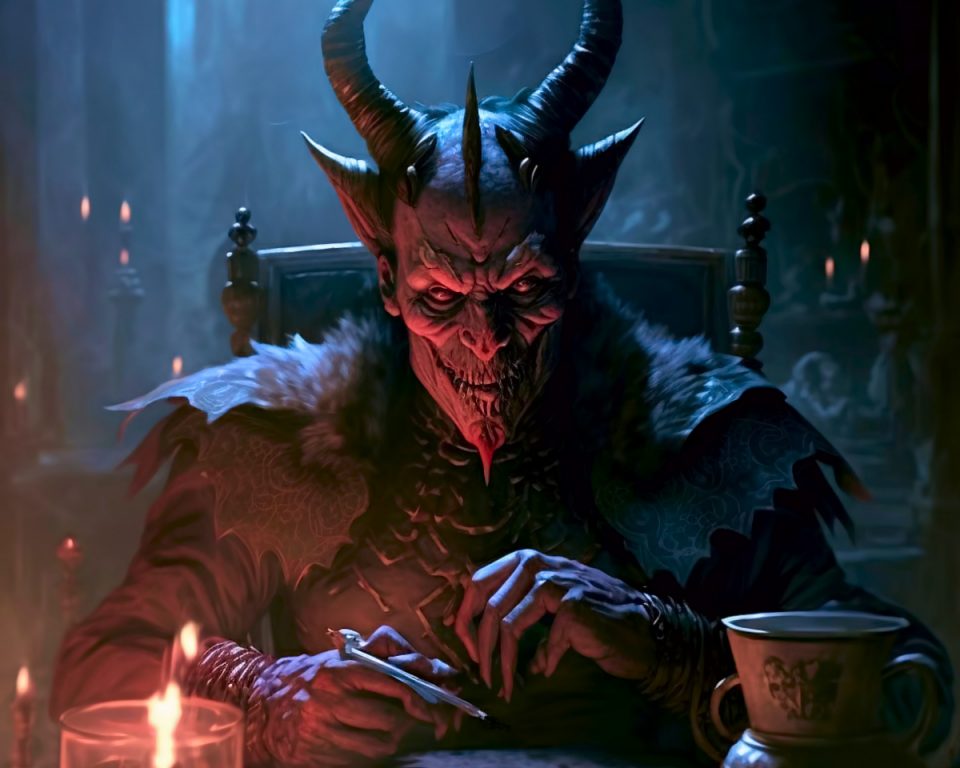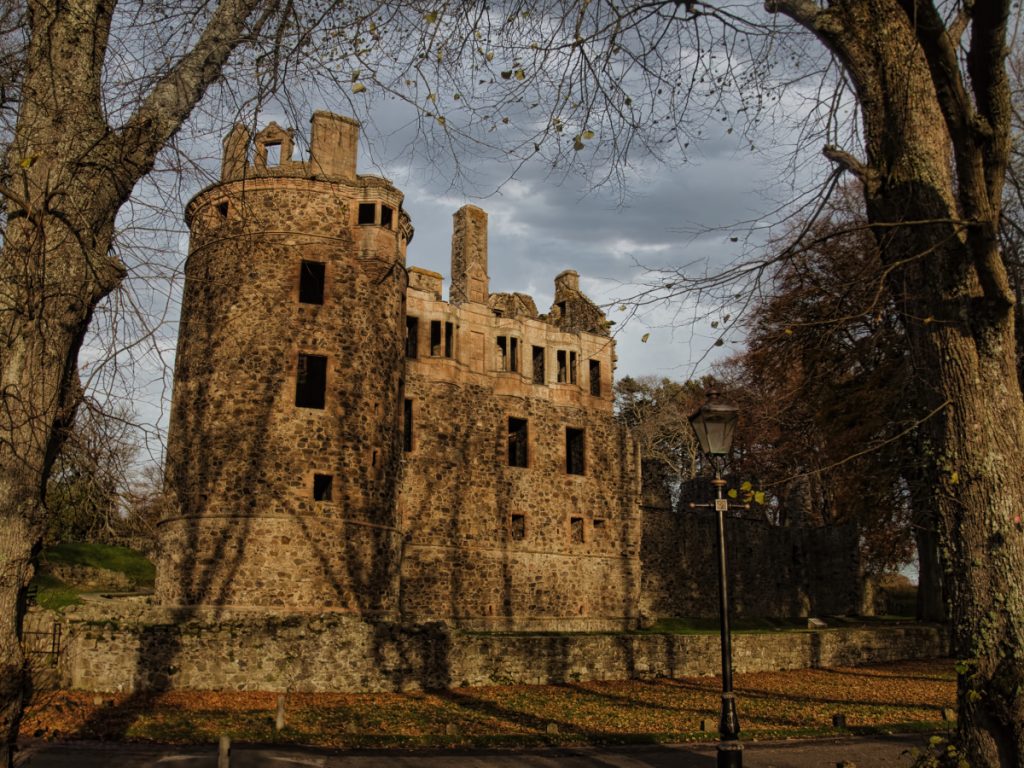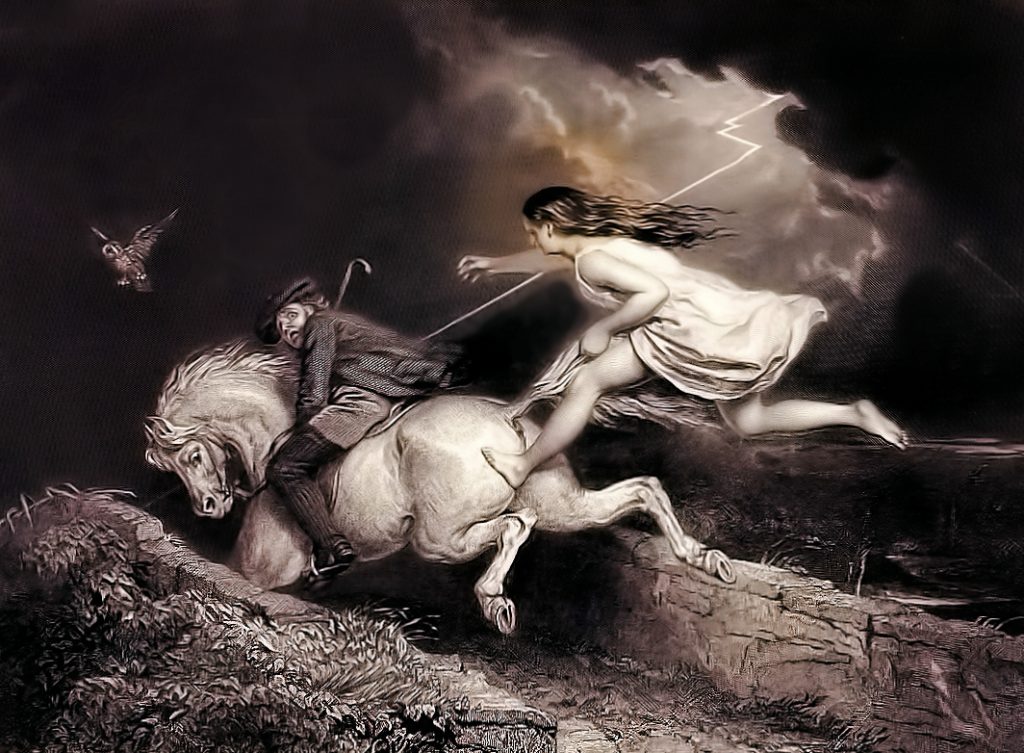The words ‘The Gorbals’ Vampire’ spread from lip to lip. Wide-eyed, the children relished the horror of the tale. It had pale skin! Its eyes were red! They glowed in the dark! It was seven foot tall! It had sharpened fangs made of iron. You will never guess where it lives! In the Gravy (The colloquial name for Glasgow’s Southern Necropolis)! Aye and that was not all! You can imagine their voices dropping to the merest whisper. With bated breath, the listeners waited. Two local children had gone missing, never to be seen again. Eaten by the monster!
No doubt, hearts raced, and knees turned to jelly. The story spread like wildfire, from child to child, from playground to playground and school to school. But these children were not the faint-hearted type who might sneak under the bedcovers and close their eyes tight as they relived the tale in nightmares. No!- these were some of Glasgow’s toughest, raised in poverty and with the knowledge that survival meant facing your deadliest fears.
The Gorbals’ Vampire Hunt
Soon the children began reporting that they had seen the monstrosity for themselves, or at least they knew a friend who had seen it. Not willing to sit back and wait to be its next meal, the school children hatched a plan. As the school bell rang at 3 pm on September 23 1954, some four hundred children raced out of the school grounds and headed for the Southern Necropolis. Many had makeshift weapons: kitchen knives, sharpened sticks, stones, and even the odd dog was enlisted to help in the search. And they were determined to kill the vile creature!
Eye Witness accounts of the Gorbals’ Vampire Hunt
Ronnie Sanderson was eight years old when he got involved in the hunt. Later he would say of the evening in question:
“It all started in the playground – the word was there was a vampire and everyone was going to head out there after school. At three o’clock the school emptied and everyone made a beeline for it. We sat there for ages on the wall waiting and waiting. I wouldn’t go in because it was a bit scary for me. I think somebody saw someone wandering about and the cry went up: ‘There’s the vampire!’ That was it – that was the word to get off that wall quick and get away from it. I just remember scampering home to my mother: ‘What’s the matter with you?’ ‘I’ve seen a vampire!’ and I got a clout round the ear for my trouble. I didn’t really know what a vampire was.”
Another of the erstwhile vampire hunters, Kenny Hughes, said:
‘We were told – or we picked up in school – that it was somebody called the Man with the Iron Teeth. We started to scream, “Who’s this man with the iron teeth?” And he apparently had big fangs that come down like a walrus or something.’
He also stated that: the children’s terror ‘built up and built up until it basically became mass hysteria.’
An Eerie Backdrop for the Gorbals’ Vampire
Tam Smith who also took part in the hunt later recorded:
‘The red light and the smoke (from the Dixon Blazes steelworks) would flare up and make all the gravestones leap. You could see figures walking about at the back all lined in red light.’
Imagine the children’s horror when a bonfire was sighted in the vicinity of the cemetery! Even more, screams erupted from the terrified youngsters. The vampire was burning its victims!
Police Intervention
The locals called the Police and soon Constable Alex Deeprose was dispatched. Arriving at the scene, he stared in amazement as children ranging from four to fourteen- armed with stakes and crosses- hunted amongst the crumbling tombstones. There were even some adults in the mix.
He records:
“When I appeared, I felt like the Pied Piper of Hamelin. All shapes and sizes of children streamed after me, all talking at once, and telling me of the ‘vampire with iron teeth’. This I could handle but when grown-ups approached me and asked earnestly ‘Is there anything in this vampire story?’ it made me think.”
However, the children were not easily dispersed. More police arrived but still, they were intent on hunting down the monster. Eventually, Edward Cusick the Headmaster of St Bonaventure’s Primary School was called out and gathered the pupils together to reassure them that the vampire story was untrue. Then, in typical Scottish fashion, the rain came on and the children left. But over the next few nights, a small but persistent group of vigilantes continued their search in the graveyard.
Medieval Origins of the Gorbals
The Gorbals is an area located on the south side of the River Clyde. It sprung up as a village separate to Glasgow in Medieval times but as Glasgow spread with the arrival of heavy industry, the once-time village became swamped. There is an interesting myth about how its name was derived.
Around 1340, a Leper’s House was established in the Gorbals at a hospital known as St Ninian’s Croft. It is said that when the Lepers would cross the Gorbals bridge, into Glasgow proper, they would ring handbells to warn the uninfected of their approach- the so-called ‘Gory bells’.
Life in The Gorbals
In time the Gorbals became the centre for Glasgow’s heavy industry. It gained a reputation for being one of Glasgow’s most poverty-stricken districts. By the end of the 19th Century, it was blighted by overcrowding and poor sanitation. However, many people were enticed to the Gorbals by the prospect of work by firms which provided worker housing. Few could afford their own homes.
Such was the wretched poverty of the area that in 1900, there was an outbreak of Bubonic plague, most likely brought into Glasgow by ship and then spread by rats through the cramped and unsanitary conditions.
As Glasgow’s heavy industry went into decline, unemployment grew and with it came an increase in crime and drunkenness. Still, migrants poured into the Gorbals’ tenement buildings: rural migrants from the Scottish Highlands and whole communities of Irish Catholics, Italians and Jews. Therefore, by the 1930s around 90, 000 residents lived in the Gorbals giving it a population density of 40,000 per square kilometre. Therefore, the infant mortality rate was high in the area. Is it any wonder that under such conditions the children imagined up a child-killing monster like the Gorbals’ Vampire?
What were the Origins of the Gorbals’ Vampire?
Nobody knows how the story began but Guy Holland, from the Gorbals’ Citizens’ Theatre, has a theory:
‘The local area at that time was dominated by Dixons Blazes, the iron foundry that would go 24/7, belching out smoke with the night sky lit up orange.’
‘There was clanking noises of metal going on and the area was polluted and smelt pretty foul – and it was directly behind the Necropolis.’
‘I think that might have had as much to do with it as anything else – kids knocking about in the graveyard at night and all the smoke and colour going on, the noise. It is a potent mix.’
In the cramped, crowded tenements of the Gorbals, the only green space for the children to play in was the Southern Necropolis. Here the children would meet and fuel their fertile imaginations with ghost stories.
Local Myths Play a Role in Gorbals’ Vampire Story.
Perhaps some of the local lore played on the minds of the children. For instance, naughty children were often threatened with a visit from the Iron Man, a kind of local Ogre. Is this where the Gorbals’ Vampire got its Iron teeth?
Or perhaps from another Glaswegian ghoul, ‘Jenny wi’ the Airn (iron) Teeth’. She was said to have been a hideous witch said that prowled around Glasgow Green in the early 1800s. Jenny was infamous for devouring children who refused to go to sleep. A rhyme was written to scare children to their beds:
Jenny wi’ the Airn Teeth
Come an tak’ the bairn (child)
Tak’ him to your den
Where the bowgie bides (bogie lives)
But first put baith (both) your big teeth
In his wee plump sides.
Biblical Influences and the Gorbals’ Vampire
In addition, there was a strong religious feeling amongst those who lived in the Gorbals’ tenement buildings and it is also possible that the children were exposed to an iron-toothed monster which appears in the Old Testament’s Book of Daniel:
‘Behold a fourth beast, and dreadful terrible, and strong exceedingly, and it had great iron teeth.’
What is the significance of the Vampire’s Iron teeth?
Somehow it seems that in a world dominated by iron, it is significant that the Gorbals Vampire was given iron teeth. Iron was the lifeblood of the Gorbals. In one form or another, it had put food into the bellies of those who lived in the Gorbals, whether from shipbuilding, working in the munition’s factories during World War II or from the local iron foundry.
But there was a dark side to iron. Iron had bred poverty. The steelworks had loomed over the Gorbals, polluting the atmosphere with noise, light and chemicals as well as endangering the lives of those who worked in the foundry. Therefore, in the children’s minds, iron was a monster that could kill. Subconsciously, it morphed into a vampire and grew wings as mass hysteria swept through the children.
The media and the Gorbals’ Vampire
The story made the national press. It soon became apparent that there were no missing children that had been kidnapped by a vampire or any other creature. However, the media firmly laid the blame at the door of American comic books with chilling tales such as ‘Tales from the Crypt’ and ‘The Vault of Horror’. Alas, these books were corrupting the imaginations of children. The media demanded that political action be taken to prevent more young minds from being ‘polluted’ by these ‘terrifying and corrupt’ comic books. Apparently, in the December 1953 issue of Dark Mysteries, there was a story entitled, ‘The Vampire with the Iron Teeth’. This was said to be the apparent source of the mass hysteria.
But the reality was that American comic books would have been like gold dust amongst the poverty-ridden children of the Gorbals. None of the children had no television at home. Many had never even read a comic. Most of the children had no idea what a vampire even was. Unfortunately, the main issues driving the hysteria had largely been ignored.
Debate Over the Gorbals Vampire in Parliament
With the media baying for blood, a strange coalition formed between the Teachers’ Union, some Christian groups, and the Communist Party (who wanted to stop American influence from spreading into the United Kingdom). Consequently, they put pressure on the government to debate the issue in Parliament.
As a result, the Gorbals’ MP, Alice Cullen spearheaded a new act to protect children from harmful publications. The Children and Young Persons (Harmful Publications) Act, became law in 1955 and is still in existence today.
The irony is that nothing could have been more wholesome than Scotland’s home-grown comics such as ‘The Beano’, ‘The Dandy’, ‘Oor Wullie’ and ‘The Broons’.
The changing world of the Gorbals
Fortunately, life in the Gorbals has changed dramatically. Social Justice issues have now been tackled and new housing has been built. But perhaps something is missing; this was a community that produced its fair share of ‘rough diamonds’. It was a community that gave its children the resilience to go into a cemetery and face their wildest fears!




